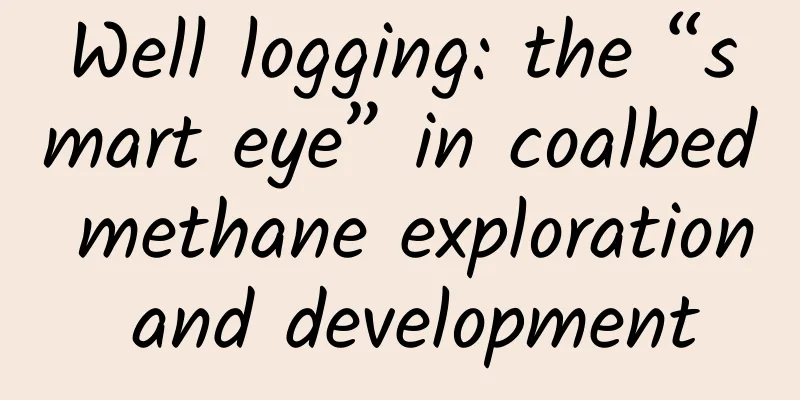Well logging: the “smart eye” in coalbed methane exploration and development

|
The exploration and development of coalbed methane mainly includes geological exploration, geophysical exploration, drilling, logging, well logging, cementing, completion, perforation, drainage, surface gathering and transportation, etc. Through the close connection and cooperation of each link, the process of coalbed methane from underground exploration and discovery to surface production is realized. Among them, well logging, also known as geophysical logging, is one of the necessary means to discover coal seams and coalbed methane resources. It is often referred to as the "eyes" of geologists. Geologists use this pair of "smart eyes" to obtain various rock physical parameters of coalbed methane reservoirs, and then clarify the characteristics and conditions of coal seams, so as to provide technical support for finding favorable zones and distribution patterns for coalbed methane generation and accumulation, so as to achieve the purpose of identifying coalbed methane reservoirs. Coalbed methane reservoir characteristics Coal seams are solid combustible minerals formed by complex biochemical and geological processes from the remains of plants. my country has diverse geological characteristics, and coal reservoirs and coalbed methane reservoir environments are also different. The thickness varies from thin coal seams less than 1 meter to very thick coal seams up to 130 meters. They are generally shallow in burial depth, low in hardness, and easy to fracturing and mining. Coal reservoirs usually have dual pore structure characteristics (a natural fracture network composed of matrix pores, micropores, cleats, and microcracks) (Figure 1). Their fragility, low porosity and low permeability, strong heterogeneity, and easy expansion make the logging response characteristics to coal seam gas content unclear, which brings great difficulties and challenges to logging interpretation and evaluation. Compared with other types of oil and gas, coalbed methane has its own particularity. It is a by-product of coal and exists in the pores of coal seams. Its state of occurrence is similar to that of shale gas, with the characteristics of self-generation and self-storage. It exists in three forms of hydrocarbon gas: adsorption on the surface of coal matrix particles, free state in coal seam separation and pores, and dissolved state in water (very small content). These three gases in different states of occurrence are in dynamic equilibrium together. The production of coalbed methane is a dynamic equilibrium process of desorption, diffusion and seepage. When the fluid pressure in the coal seam decreases, the adsorbed coalbed methane on the surface of coal matrix particles is transformed into free coalbed methane through desorption. The free coalbed methane enters the cracks of the formation through diffusion or seepage of the coal matrix. Finally, the free coalbed methane in the cracks reaches the wellbore through seepage and is produced. The amount of coalbed methane is mainly affected by geological structure, coalification degree, coal seam occurrence conditions, and top and bottom plate surrounding rock characteristics. Well logging is the process of using all kinds of skills, including geology, rock mechanics, mathematics, artificial intelligence and big data, to accurately characterize the coal seams from the microscopic nanopore structure to the macroscopic micropore structure, so as to "take the pulse" and "diagnose" the coalbed methane. The Origin and Development of “Wisdom Eyes” Well logging is a process of developing high-precision instruments based on the research of physical processes such as sound, electricity, nuclear power, and magnetic fields. These instruments are placed hundreds or even thousands of meters underground, and various parameter signals reflecting the rock formations and the fluids in the rock formations are obtained through measurement. Interpretation and evaluation personnel use these parameter signals to reveal the secrets of underground coalbed methane treasures and achieve accurate positioning of coal and gas. This is the origin of well logging being referred to as "wise eyes". Since the 1920s, the development of well logging has roughly gone through four stages: analog logging, digital logging, CNC logging, and imaging logging. In the analog logging stage, the data collection method was single, using analog recording to manually draw the data on the drawing, and its main function was to qualitatively identify oil and gas layers. In the digital logging stage, digital recording and computer processing were used to obtain data. The logging methods and collection projects began to be improved, and the logging interpretation and evaluation methods were greatly developed. The quantitative evaluation and comprehensive analysis of oil and gas can be achieved, and it plays a role in the reservoir evaluation of complex igneous rocks, buried hills and other oil and gas reservoirs. In addition, the logging technology began to develop into the fields of geology and oil reservoirs. In the CNC logging stage, the matching of logging instruments and collection projects has become increasingly mature, and the data collection and processing technology has developed by leaps and bounds. A variety of supporting logging data meet the requirements of complex lithologies such as fractured reservoirs and thin interbeds, thanks to the rapid development of computer and microelectronics technology. The imaging logging stage is the stage we are in now. Its outstanding feature is that imaging acquisition realizes all-round measurement of the formation, the data acquisition capability is improved exponentially, and data processing realizes three-dimensional imaging around the well, which is more accurate and intuitive than before. The latest generation of logging equipment reflects the high, precise and advanced modern technology everywhere. In the 2021 National "13th Five-Year Plan" Science and Technology Innovation Achievement Exhibition, it was exhibited side by side with the 600 km/h high-speed maglev train. Modern logging interpretation and evaluation methods have broken the "one-hole view" and continuously extended to the fields of geological structure, testing, fracturing transformation, engineering evaluation, etc., playing an important role in the exploration and development of more complex and hidden oil and gas reservoirs. For the coalbed methane vertical wells currently being explored and developed, the logging collection and methods used are mainly borrowed from oil and gas logging technology. During decades of development and application, a series of coalbed methane logging technologies and methods have been formed, including electrical logging, acoustic logging and radioactive logging, providing a pair of bright "eyes" for finding coal and gas. The role of “wisdom eye” The logging response characteristics of coalbed methane reservoirs can be determined by using natural gamma, natural potential, acoustic wave, density, neutron, lateral or induction resistivity in conventional logging, which can be summarized as "two lows and three highs": low density, low natural gamma, high neutron, high acoustic time difference, and high resistivity. Through logging research, the current logging interpretation methods and processes of coalbed methane have been basically formed, and the concept of "coalbed methane system" has been innovatively proposed. The coal seam, top and bottom plates, and upper and lower strata are systematically studied as a whole. For the research on medium and shallow coalbed methane, a "coalbed methane system logging comprehensive evaluation technology system" has been formed, which includes 5 categories and 16 special coalbed methane logging evaluation technologies, with the aim of solving the four-property evaluation problem of coalbed methane: "reservoir, gas content, water content, and compressibility". In actual evaluation applications, different types of logging technologies need to be combined for different geological conditions and exploration and development purposes at different stages to obtain more accurate logging reservoir parameters and achieve the purpose of accurate logging evaluation of coalbed methane. For example, the basis of coalbed methane reservoir logging evaluation is the rock physics volume model. Due to the difference in the components of coalbed methane reservoirs and oil and gas reservoirs, a coalbed rock physics volume model considering organic components is constructed by drawing on coal geology, and the industrial components of coal seams are divided into fixed carbon, volatile matter, ash, and moisture. For different coal seam industrial components, logging interpretation models of each component are established through gamma, density, and acoustic wave information in logging to achieve quantitative calculation of coal seam components. It should be noted that since the characteristic attributes of coalbed methane reservoirs are affected by the superposition of multiple factors, the response of logging information presents a nonlinear law, and conventional oil and gas interpretation and evaluation methods are no longer applicable to coalbed methane reservoirs. With the rapid development of the coalbed methane industry, the new generation of logging instruments and evaluation methods have also made great progress. The use of electrical imaging logging can clearly reflect the characteristics of the wellbore, accurately divide the coal seam interlayers, analyze and evaluate the roof and floor plates and fracture development of the coal seam, and realize the quantitative identification of the coal body structure. Nuclear magnetic logging can accurately calculate the porosity of coal seams, analyze the fluid components and their multi-scale pore structure characteristics. Array acoustic logging can be used to identify coal seams, conduct evaluations of coal seam rock mechanical properties, acoustic anisotropy, etc., and provide reference data for fracturing construction design. These new logging technologies have achieved fine logging evaluation of coal seams with their unique advantages, making up for the shortcomings of conventional logging technology. With the rapid development of oil and gas industry technology, the exploration and development of coalbed methane is accelerating. The application of logging technology in coalbed methane exploration and development also has its limitations. In coalbed methane drilling and ground information collection, the fragile nature of coal seams leads to wellbore collapse and collapse, which in turn causes distortion of logging acquisition signals, making the logging curve values unable to truly reflect the actual situation of the coal seam. For example, the expansion of the wellbore causes the density and neutron curves of conventional logging to decrease and increase abnormally. The nuclear magnetic imaging logging data is affected by the wellbore drilling fluid, and the measured data is distorted. In severe cases, logging acquisition cannot even be completed. In terms of the vertical resolution of logging instruments, the gamma and density vertical resolutions in conventional logging are low, which is not enough to accurately divide the thickness of thinner coal seams and identify the liver. In the calculation of gas content, the classic Archie formula that uses resistivity to calculate saturation in conventional oil and gas cannot be used because of the complex electrical differences of different coal ranks in the coal seam. In soft formations such as coal seams, the amplitude of shear waves and Stoneley waves in the array acoustic waves decays rapidly. How to accurately and effectively extract the wave train information is a practical problem facing researchers. At present, the logging evaluation technology and methods of coalbed methane cannot fully meet the technical needs of the rapid development of the modern coalbed methane industry and the exploration and development of deep coal and rock. With the in-depth development of coalbed methane, exploration and development are moving towards deep coal and rock gas. People not only need to know the porosity, permeability, gas content, roof and floor, fracture development and other conditions of coal seams, but also need to further understand the development of coal seam wells to solve problems such as water production on site, unknown gas content, unclear sweet spots and unknown favorable areas of coalbed methane. In view of these limitations and evaluation difficulties, logging technology needs further research and development. Author: Zeng Jingbo, Zhang Fengsheng, He Yufei, Chang Jinyu (Geological Research Institute of China National Petroleum Corporation Well Logging Co., Ltd.) |
<<: Beware! Your old phone may reveal your privacy
>>: Who could be the real culprit behind the Beihai wounding incident?
Recommend
CITIC Securities 2021 Research Methods Training (Shanghai Station)
CITIC Securities 2021 Research Methods Training (...
Xbox One system detailed analysis: the complete Windows 8
A few months ago, several news outlets reported th...
Why is it so important for older people to get vaccinated against the new coronavirus?
Increasing the COVID-19 vaccination rate among th...
Tourist's hair suddenly stood up, netizens reminded: Get out of here! Experts said: Don't run around!
Recently, in Turpan, Xinjiang Tourists' hair ...
How to design a popular H5? 5 tips to make you a master!
It’s time to learn more. A few days ago, an H5 ad...
ViaPlay F2 game controller review: a game controller that beats touch screens
Hello guys~ Today we The packaging is very straig...
Pre-installed apps on cheap Android phones pose serious security risks
In a study funded by the U.S. Department of Homel...
Supernova warning! Astronomers have discovered a way to predict when stars will "self-destruct"
Supernova warning! Astronomers have discovered a ...
The ninth episode of the Aiti Tribe Clinic: Java, Python, PHP, they all say they are simple
【51CTO.com original article】 Activity description...
Several methods to implement delayed operation in Android development
Using Handler and Runnable The Handler class can ...
"Meteors" and "spacecraft", the brave ones flying through the air
Meteor showers have always been a romantic and my...
What should you do if you have spring allergies and tears?
Since March, the number of patients suffering fro...
Commercialization and monetization guide: How to improve the eCPM of information flow advertising?
Information flow advertising is almost a must for...
Is it true that the national average daily number of inbound arrivals is 120,000? Pay attention to these travel precautions!
At present, the epidemic situation in our country...
Sanming SEO Training: What should SEO pay attention to? What are the changes now?
Baidu search engine optimization includes many as...









